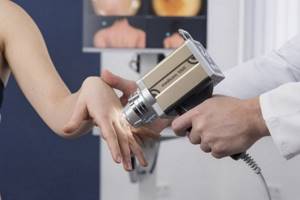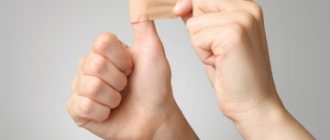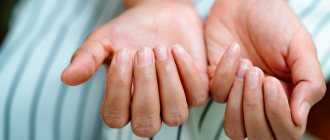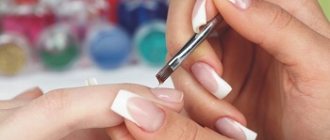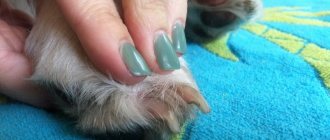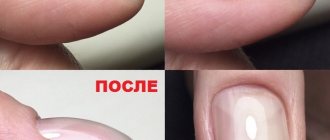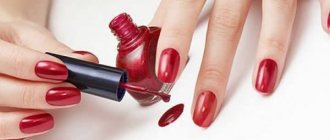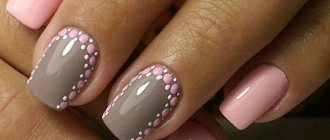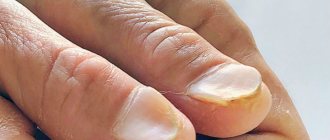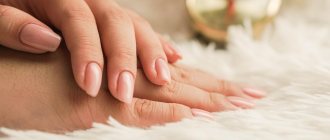Often, men and women of any age are faced with such a problem as the appearance of grooves on their nails. They are convex stripes on the nail plate that spoil the appearance of the hands and prevent the implementation of standard hygiene procedures. The problem should not be ignored, since the symptom signals a malfunction in the body, as well as the presence of possible diseases.
Causes of nail deformation
What are the causes of grooves on nails? There are a number of factors that provoke such changes. They include:
Low zinc levels. The appearance of grooves on the nails is associated with a lack of beneficial microelements, which are most often found among vegetarians and people who adhere to a healthy diet. Their diet consists of plant products.
Incorrect polishing and poor quality manicure. For work, the master uses special tools, the surface of which has a strong impact on the matrix of the nail plate. Similar changes appear among girls who abuse artificial nail extensions. During the procedure, the master incorrectly moves the posterior periungual fold.
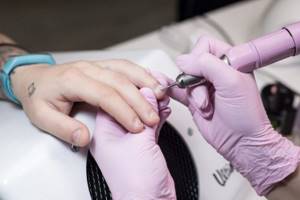
Frequent injury to the matrix and cuticle. Matrix cells take a long time to recover due to a lack of nutrients. The procedure of unprofessional trimmed manicure can provoke the appearance of grooves. Regular use of household chemicals without protective gloves provokes a slowdown in metabolic processes on the skin of the hands.
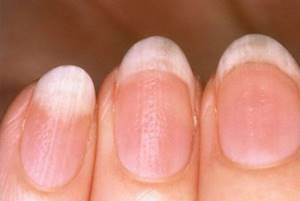
The presence of serious diseases and various types of infections is accompanied by a cessation of nail growth and rapid growth of the cuticle, which occupies most of the nail bed and provokes the growth of grooves.
Regular stressful situations. Frequent irritants provoke disruptions in the body's immune defense. During this period, immune cells are activated in favor of the organ that is weak and defenseless.
Treatment options
There is no single cure for this disease. If the nail defect is caused by a certain disease, its disappearance will occur on its own some time after recovery.
Taking care of your nails is an important factor influencing their condition.
When the exact diagnosis is unknown, it is necessary to undergo a full examination to establish it. Moreover, the lines that form on the nail plates do not themselves require drug treatment. This problem should be addressed to a cosmetologist.
What diseases are caused by the appearance of stripes?
Deformation of the nail plate in the form of transverse and longitudinal stripes can occur on several fingers. What do such deformations indicate?
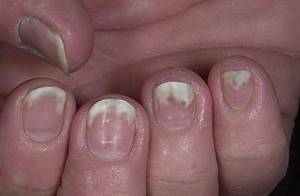
There is a list of pathological changes in the human body, accompanied by changes in the structure of the nail:
- Joint disease;
- Pathologies in the cardiovascular system;
- Skin diseases. Psoriasis is considered a common cause of the appearance of grooves on the surface of the nail;
- Regular stress and nervous shock;
- Mechanical injuries of the spinal cord.
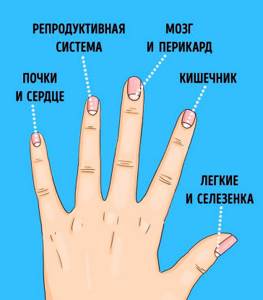
A lack of zinc in the human body provokes serious pathological reactions, manifested in the form of:
- Infectious diseases;
- Changes in the gastrointestinal tract;
- Pathologies of the pancreas;
- Impaired blood circulation.
Symptoms of onychodystrophy
External manifestations of onychodystrophy depend on its type. However, in all cases, in addition to visual changes in the shape, structure, strength, and color of the nail plate, signs of local inflammation may additionally occur. In such situations, patients may notice redness and swelling of the skin in the area of the affected nail, as well as experience pain of varying intensity when pressing on the nail or constantly.
Today there is no strict and generally accepted classification of onychodystrophies. Therefore, as a rule, dermatologists divide them according to the reasons for their development, with an emphasis on the specifics of external manifestations.
In general, a distinction is made between congenital and acquired onychodystrophies. The former are a consequence of gene mutations, and the latter are the result of malnutrition of the nails under the influence of external and/or internal factors. In this case, acquired onychodystrophies are divided into isolated ones and those that arise against the background of the development of other diseases.
The symptoms of onychodystrophy are very similar to the manifestations of onychomycosis, i.e. fungal infection of the nails. This causes a number of difficulties in its diagnosis.
Who is at risk?
Experts identify a group of people who experience pathological changes on the nail plates. These include:
- Teenagers aged 11 to 15 years. During this period, they experience a deficiency of beneficial vitamins and microelements. Substances participate in active growth and provoke unbalanced metabolic reactions;
- Pregnant and lactating women. When carrying a fetus, women notice a lack of nutrients in their bodies. Breastfeeding indicates a deficiency of zinc, B vitamins, calcium and iron;
- People suffering from diabetes;
- Puberty. At this time, hormonal changes occur in the human body;
- Pathology of the respiratory system;
- Changes in the performance of the nervous system.
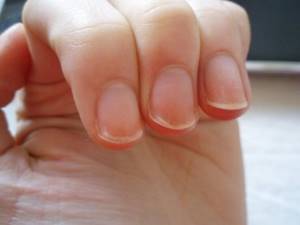
What is onychodystrophy
A human nail has a root, a body, i.e. the visible part of the nail, a free edge and a matrix in which the basal cells multiply. They form and move towards the root of the nail, gradually flattening and becoming keratinized. This ensures continuous growth of the nail plate. Between the keratinized cells of the nail and its root is the so-called lunula. It is crescent-shaped and white in color, with a cuticle running along its flat edge. It is a sheath at the base of the nail plate that protects the nail root from damage by pathogenic microorganisms. The nail is limited on 3 sides by folds of skin called ridges. On the side of the free edge there is a thin layer of skin called hyponychium. Over the entire area, except for the free edge, the nail plate is adjacent to the nail bed. It is formed by connective tissue, which is rich in nerve endings and blood vessels.
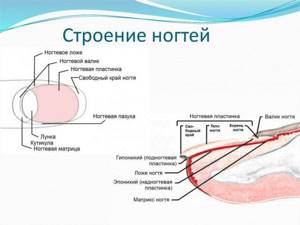
When disturbances occur in nutrition, metabolism, or changes in the chemical composition of nails under the influence of certain factors, onychodystrophy develops. Moreover, its appearance directly depends not only on the nature of the influencing factors, but also on the characteristics of the chemical composition of the nails, since it can vary quite widely among different people.
As a result of the accumulation of metabolic products in the cells and intercellular space, the structure of the cells of the nail plates may change. This leads to onychodystrophy, which can be manifested by impaired nail growth, its detachment from the bed, brittleness, delamination, the formation of spots, cracks, stripes, etc.
Onychodystrophy is a disease that does not have age, seasonal, racial or other characteristics. It can act as a symptom of the development of other somatic disorders or an independent pathological process. But in any case, onychodystrophy should not be ignored, and its appearance should be considered as the first sign of the occurrence of other disorders in the body until the contrary is proven.
Onychodystrophy can affect both fingernails and toenails. In this case, not all nails may suffer at once, but only one or several.
The importance of timely diagnosis and treatment of the disease is also due to the fact that it can lead to the development of complications. The most dangerous consequences of the lack of treatment for onychodystrophy of any kind are:
- Onychomycosis is a fungal infection of the nail plate, very common in advanced onychodystrophies. As a result of the addition of a fungal infection, the nails become even more deformed and change color, and subsequently the pathogenic microflora through the bloodstream can spread throughout the body and lead to mycoses of internal organs, the development of severe allergies to a number of medications and other complications.
- Subungual melanoma is a serious oncological disease characterized by an aggressive course and capable of claiming lives. It is characterized by the formation of a dark spot of any shape, stripe, etc. under the nail. The disease requires immediate consultation with a doctor.
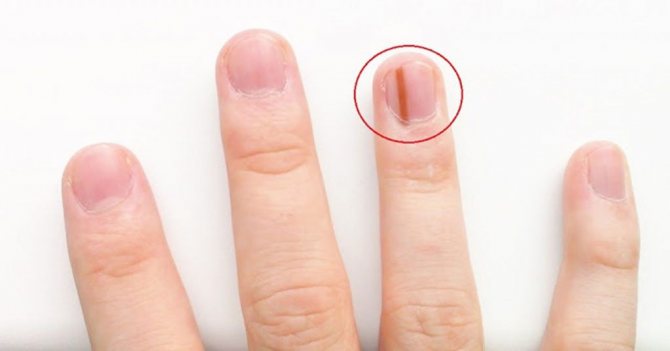
How to treat?
What to do if grooves appear on your nails? If any deformations are detected on the nail plates, it is recommended to seek medical help to diagnose the exact disease. To do this, you should visit the office of a mycologist and dermatologist.
If a specialist identifies a serious disease, the patient will be prescribed a course of procedures to identify the form and speed of the pathological process. The results will help you choose the appropriate treatment for the nail grooves, which will prevent further deformation of the nail bed.
If the nail was injured during a poor-quality manicure, then polishing will help stabilize the condition of the horny epithelium.
This process requires a professional approach. Incorrectly selected equipment provokes the emergence of new problems.
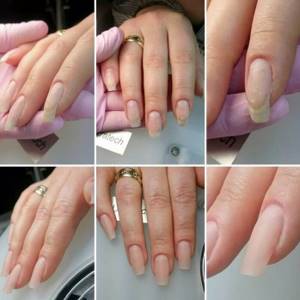
What needs to be taken into account when leveling the grooves on the fingernails? Several rules have been developed for this. They include the following recommendations:
First, the doctor must identify the main cause of the deformity. If such changes were caused mechanically, then the specialist will determine the amount of polishing to file down the grooves.
The master must remove a minimum amount of horny epithelium at a time. Neglect of this requirement provokes severe thinning of the nail plate. It will react to changes in temperature and cause discomfort in everyday life.
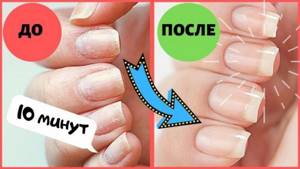
Injury to the cuticle worsens the external condition of the nail. That is why during the procedure it is recommended to be careful when working with manicure equipment. Here it is important to take into account the force on the nail file, as well as to carry out the correct movements.

Polishing should be done in one direction. In this way, the horny epithelium will maintain its integrity and its structure will not be disturbed.
First, the master must select the size of the nail file. If the grooves are too high, then to eliminate them you will need a file of medium hardness.
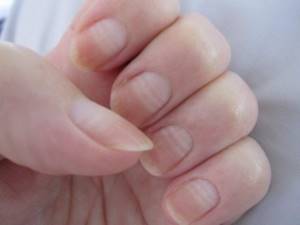
It is recommended to polish once every 2 weeks. During this time, the nail plate will be able to recover on its own. Her sensitivity will decrease and her external condition will improve.

At the end of the procedure, it is recommended to treat the client’s nails and hands with an antiseptic solution. It will help prevent the proliferation of pathogenic microflora and improve the regeneration process at the cellular level.
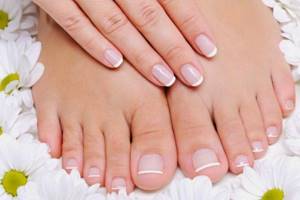
Prevention
Prevention methods include proper care of hands and nails, as well as a balanced diet.
- If you prefer to do your own manicure, be especially careful with your cuticles. If you damage the nail growth zone, which is located exactly in this place, then problems with the nails will certainly occur, since the blood supply is disrupted, and therefore the nutrition of the nail plate.
- If you can’t do a quality manicure yourself, use the services of a professional. When choosing a nail salon, preference should be given to one that has proven itself. Make sure your tools are disinfected or bring your own. But don’t forget that your own manicure tools also need to be disinfected after each use.
- Care products must be of high quality. If you have defects in your nails, it is best not to use polish for a while.
- The diet must include fresh vegetables, fruits and herbs. But it’s better to avoid sweets and starchy foods. Fatty foods should also be limited.
- At least twice a year you need to take a course of complex vitamins. This will improve the condition of your skin, nails and hair.

Photo of grooves on nails
Diagnostics
If signs of onychodystrophy occur, you should contact a dermatologist who will interview and examine the patient, including using a dermatoscope. It is a compact device that provides a multiple magnification of the surface under consideration.
If necessary, the doctor will additionally prescribe a blood test, nail microscopy and bacterial culture. These tests are mainly required to diagnose infectious complications of onychodystrophy.
